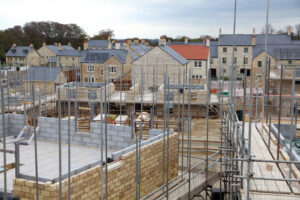SAP in Scotland can be much more challenging than England and Wales. Let’s look at why.
For a new home, the main target for SAP in Scotland and the rest of the UK is to get the DER (Dwelling Emission Rate) equal to or below the TER (Target Emission Rate).
The DER is based upon the actual (or proposed) specification, and the TER is calculated by creating a ‘notional dwelling’ with the same dimensions as the one specified, but using ‘reference values’ for various aspects such as U-values and heating efficiencies, and then calculating that building’s CO2 emissions. It’s the difference in these reference values that cause the difference between SAP in Scotland, and England and Wales.
The different reference values lead to a different TER. The lower the TER, the lower your DER must be to meet compliance.

England and Wales currently use Part L1a of the Building Regulations 2013, and SAP in Scotland is used to prove compliance with Section 6 of the Scottish Building Standards 2016.
So what’s expected under SAP in Scotland?
The key difference between L1a and Section 6, is that Section 6 assumes some kind of renewable energy in the notional dwelling (whereas L1a currently does not have renewable energy in the notional dwelling). This will reduce the TER, meaning your proposed dwelling must also reduce emissions to this level to comply. The actual renewable energy specified in the notional dwelling depends on the fuel specified in your proposed dwelling, as shown below.
|
Notional Specification |
||||
|
Specified Space Heating Fuel Type in Propsed Dwelling |
Space Heating System |
Water Heating System |
Secondary Heating |
Solar PV |
|
Gas |
Gas boiler |
From boiler |
None |
Yes |
|
LPG |
LPG boiler |
From boiler |
Wood burner |
Yes |
|
Oil |
Oil boiler |
From boiler |
Wood burner |
Yes |
|
Electricity |
Air-water heat pump |
Electric immersion |
Electric heaters |
No |
|
Biomass |
Wood pellet boiler |
From boiler |
None |
No |
- If you have gas, LPG, or oil providing your space heating, the notional dwelling will have solar PV specified. In addition, LPG and oil will also have a wood burner providing 10% of the space heating.
- If you have electric space heating specified, the notional dwelling will assume an air source heat pump providing the space heating, with the hot water and 10% of the space heating being provided through electric heating.
- If you have biomass heating, the notional dwelling will also assume biomass heating.
The kWp of the notional solar PV is 1% of the total floor area (or the solar PV area is limited to 30% of the roof area if this is smaller, assuming 0.12kWp per m2 PV area). The PV is assumed to be facing SW at a 30° pitch.
So unless you use a heat pump or biomass boiler, realistically you’re going to need solar PV to meet compliance through SAP in Scotland.
Further differences between England/Wales and Scotland are as below:
|
Location |
England/Wales |
Scotland |
|
Building Regulations Standard |
L1A 2013 |
Section 6 2015 |
|
Wall U-value |
0.18 |
0.17 |
|
Floor U-value |
0.13 |
0.15 |
|
Roof U-value |
0.13 |
0.11 |
|
Windows and Roof lights U-value |
1.4 |
1.4 |
|
Opaque doors/Semi-glazed doors U-value |
1.0/1.2 |
1.4 |
|
Thermal bridging |
Reference values for each junction used |
0.08 x total exposed surface area |
|
Opening Area |
Same as actual dwelling up to 25% of floor area |
25% of floor area |
|
Opening Orientation |
Same as actual dwelling |
East/West |
|
Thermal Mass |
Medium |
Same as actual dwelling |
|
Air permeability (m3/hm2) |
5 |
7 |
|
Waste Water Heat Recovery |
None |
2 units, or 1 unit if total floor area 100m2 or less |
There are various differences such as U-values and air tightness, with some being more strict for SAP in Scotland (roof and wall U-value) and some being less strict (door and floor U-value, air permeability). The key difference to note is in the table above is that Scottish Regulations assume Waste Water Heat Recovery Systems are present in the notional specification (with the number of units depending on floor area), which further lowers the target emissions, making it more demanding to pass SAP.
Is SAP in Scotland harder to pass?
To give an example of how this all affects new builds we’ll look at a sample SAP assessment. A sample house in England has the following DER and TER. The proposed specification has gas heating and has been designed to meet compliance.
- TER = 19.25 kgCO2 per year
- DER = 18.72 kgCO2 per year (passing by 2.7%)
If current Scottish Regulations are now applied:
- TER 15.59 kgCO2 per year
- DER 18.72 kgCO2 per year (failing by 20%).
So the DER has stayed the same but the TER has decreased from 19.25 to 15.59 (19%), meaning the dwelling does not meet compliance. In this case the house would now need approximately 1 kWp of solar PV to pass, or less if other improvements such as Waste Water Heat Recovery Systems are used.
To summarise, the TER in Scotland is usually lower than in England/Wales because its notional specification assumes some renewable energy (which depends on your proposed fuel type) and also Waste Water Heat Recovery. Therefore, the proposed building will need to further reduce its emissions, which realistically means applying renewable energy itself. In most cases this will be solar PV or a heat pump. You can ask us look at both options during the SAP assessment.
Need help completing on your scheme?
Call us for a chat on 0330 055 34 05 or email be@buildenergy.co.uk.
